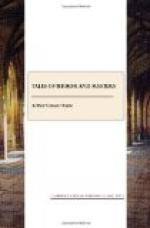“This is no novelty to an expert like yourself, Mr. Mortimer,” said he; “but I daresay that your friend, Mr. Jackson, will be interested to see it.”
Leaning over the case I saw an object, some five inches square, which consisted of twelve precious stones in a framework of gold, with golden hooks at two of the corners. The stones were all varying in sort and colour, but they were of the same size. Their shapes, arrangement, and gradation of tint made me think of a box of water-colour paints. Each stone had some hieroglyphic scratched upon its surface.
“You have heard, Mr. Jackson, of the urim and thummim?”
I had heard the term, but my idea of its meaning was exceedingly vague.
“The urim and thummim was a name given to the jewelled plate which lay upon the breast of the high priest of the Jews. They had a very special feeling of reverence for it—something of the feeling which an ancient Roman might have for the Sibylline books in the Capitol. There are, as you see, twelve magnificent stones, inscribed with mystical characters. Counting from the left-hand top corner, the stones are carnelian, peridot, emerald, ruby, lapis lazuli, onyx, sapphire, agate, amethyst, topaz, beryl, and jasper.”
I was amazed at the variety and beauty of the stones.
“Has the breastplate any particular history?” I asked.
“It is of great age and of immense value,” said Professor Andreas. “Without being able to make an absolute assertion, we have many reasons to think that it is possible that it may be the original urim and thummim of Solomon’s Temple. There is certainly nothing so fine in any collection in Europe. My friend, Captain Wilson, here, is a practical authority upon precious stones, and he would tell you how pure these are.”
Captain Wilson, a man with a dark, hard, incisive face, was standing beside his fiancee at the other side of the case.
“Yes,” said he, curtly, “I have never seen finer stones.”
“And the gold-work is also worthy of attention. The ancients excelled in——“—he was apparently about to indicate the setting of the stones, when Captain Wilson interrupted him.
“You will see a finer example of their gold-work in this candlestick,” said he, turning to another table, and we all joined him in his admiration of its embossed stem and delicately ornamented branches. Altogether it was an interesting and a novel experience to have objects of such rarity explained by so great an expert; and when, finally, Professor Andreas finished our inspection by formally handing over the precious collection to the care of my friend, I could not help pitying him and envying his successor whose life was to pass in so pleasant a duty. Within a week, Ward Mortimer was duly installed in his new set of rooms, and had become the autocrat of the Belmore Street Museum.
About a fortnight afterwards my friend gave a small dinner to half a dozen bachelor friends to celebrate his promotion. When his guests were departing he pulled my sleeve and signalled to me that he wished me to remain.




